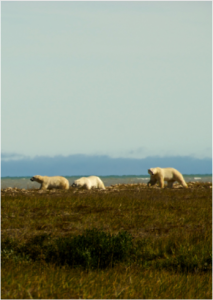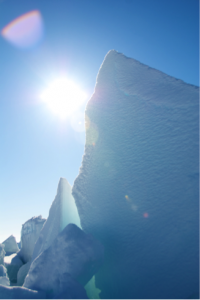 e-mail: stephen.hamilton@ualberta.ca
e-mail: stephen.hamilton@ualberta.ca
PhD Student
University of Alberta
“Polar Bear Conservation in the Circumpolar Arctic: Population, Habitat, and Climate Projections”

The scale at which habitat change occurs has significant implications on the species populations. With the earth in a period of climate warming, changes are being detected globally and therefore all species are likely to be affected in some form1. While ecosystem change is normal, the concern about present-day global warming is that it is happening too rapidly for many species to cope via generational adaptation. Approximately half the world’s land and marine mammals are in a state of decline, and one in four species is threatened with extinction due primarily to habitat loss2. In the Arctic, climate change is responsible for shrinking the average Arctic sea-ice cover, thus affecting a wide variety of Arctic marine species3.
Polar bears (Ursus maritimus) are among those marine mammals  affected by climate change4,5 as Arctic Ocean temperatures increase6 and sea-ice cover decreases7. Polar bears require sea-ice cover as a hunting platform, and some populations, such as those in the Beaufort Sea, rely on multi-year ice for denning, making this species particularly sensitive to Arctic climate change4. Habitat loss due to climate change is predicted to result in an overall reduction in the global polar bear population8.
affected by climate change4,5 as Arctic Ocean temperatures increase6 and sea-ice cover decreases7. Polar bears require sea-ice cover as a hunting platform, and some populations, such as those in the Beaufort Sea, rely on multi-year ice for denning, making this species particularly sensitive to Arctic climate change4. Habitat loss due to climate change is predicted to result in an overall reduction in the global polar bear population8.
My research focuses on polar bear habitat change due to climate warming, and the resulting effects on the population in the following ways:
- Understanding the link between Arctic environmental conditions and population.
- Examining the effects on population, spatially and numerically, based on sea-ice projection models.
- Studying the movement patterns of bears by demographic group relative to changing sea-ice conditions, and assessing the projected vulnerability due to modeled changes in habitat.
- Assessing the vulnerability of polar bears by demographic group to hunting, and the conservation implications therein.
RECENT PUBLICATION
Projected Polar Bear Sea Ice Habitat in the Canadian Arctic Archipelago
Available Online at PLOS ONE: (http://www.plosone.org/article/info%3Adoi%2F10.1371%2Fjournal.pone.0113746)
Abstract:
Background: Sea ice across the Arctic is declining and altering physical characteristics of marine ecosystems. Polar bears (Ursus maritimus) have been identified as vulnerable to changes in sea ice conditions. We use sea ice projections for the Canadian Arctic Archipelago from 2006 – 2100 to gain insight into the conservation challenges for polar bears with respect to habitat loss using metrics developed from polar bear energetics modeling.
Principal Findings: Shifts away from multiyear ice to annual ice cover throughout the region, as well as lengthening ice-free periods, may become critical for polar bears before the end of the 21st century with projected warming. Each polar bear population in the Archipelago may undergo 2–5 months of ice-free conditions, where no such conditions exist presently. We identify spatially and temporally explicit ice-free periods that extend beyond what polar bears require for nutritional and reproductive demands.
Conclusions/Significance: Under business-as-usual climate projections, polar bears may face starvation and reproductive failure across the entire Archipelago by the year 2100.
Citation: Hamilton SG, Castro de la Guardia L, Derocher AE, Sahanatien V, Tremblay B, et al. (2014) Projected Polar Bear Sea Ice Habitat in the Canadian Arctic Archipelago. PLoS ONE 9(11): e113746. doi:10.1371/journal.pone.0113746
REFERENCES:
(1) Walther et al. 2002, Nature; (2) Schipper et al. 2008, Science; (3) Laidre et al. 2008, Ecological Applications; (4) Derocher et al. 2004, Integrative and Comparative Biology; (5) Hunter et al. 2010, Ecology; (6) Zhang 2005, Geophysical Research Letters; (7) Serreze et al. 2007, Science; (8) Durner et al. 2009, Ecological Monographs.

